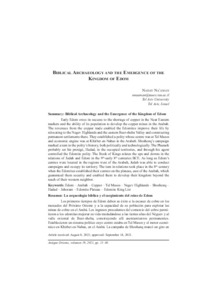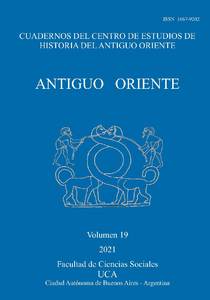Please use this identifier to cite or link to this item:
https://repositorio.uca.edu.ar/handle/123456789/14540| Título: | Biblical archaeology and the emergence of the kingdom of Edom La arqueología bíblica y el surgimiento del reino de Edom |
Autor: | Na’Aman, Nadav | Palabras clave: | ARQUEOLOGIA BIBLICA; COMERCIO; EDOM; COBRE; YACIMIENTOS ARQUEOLOGICOS | Fecha de publicación: | 2021 | Editorial: | Pontificia Universidad Católica Argentina. Facultad de Ciencias Sociales. Departamento de Historia. Centro de Estudios de Historia del Antiguo Oriente | Cita: | Na’Aman, N. Biblical archaeology and the emergence of the Kingdom of Edom [en línea]. Antiguo Oriente. 2021, 19. Disponible en: https://repositorio.uca.edu.ar/handle/123456789/14540 | Resumen: | Summary: Biblical Archaeology and the Emergence of the Kingdom of Edom
Early Edom owes its success to the shortage of copper in the Near Eastern
markets and the ability of its population to develop the copper mines in the Arabah.
The revenues from the copper trade enabled the Edomites improve their life by
relocating to the Negev Highlands and the eastern Beer-sheba Valley and constructing
permanent settlements there. They established a polity whose centre was at Tel Masos
and economic engine was at Khirbet en-Nahas in the Arabah. Shoshenq’s campaign
marked a turn in the polity’s history, both politically and technologically. The Pharaoh
probably set his protégé, Hadad, in the occupied territories, and through his agent
controlled the Edomite polity. The Book of Kings relates the ups and downs in the
relations of Judah and Edom in the 9th-early 8th centuries BCE. As long as Edom’s
centres were located in the regions west of the Arabah, Judah was able to conduct
campaigns and occupy its territory. The turn in relations took place in the 8th century
when the Edomites established their centres on the plateau, east of the Arabah, which
guaranteed them security and enabled them to develop their kingdom beyond the
reach of their western neighbor. Resumen: La arqueología bíblica y el surgimiento del reino de Edom Los primeros tiempos de Edom deben su éxito a la escasez de cobre en los mercados del Próximo Oriente y a la capacidad de su población para explotar las minas de cobre en el Arabá. Los ingresos procedentes del comercio del cobre permitieron a los edomitas mejorar su vida trasladándose a las tierras altas del Néguev y al valle oriental de Beer-sheba, construyendo allí asentamientos permanentes. Establecieron un sistema político cuyo centro estaba en Tel Masos y el motor económico en Khirbet en-Nahas, en el Arabá. La campaña de Shoshenq marcó un giro en la historia de la ciudad, tanto en lo político como en lo tecnológico. El faraón probablemente colocó a su protegido, Hadad, en los territorios ocupados, y a través de su agente controló el sistema político edomita. El Libro de los Reyes relata los altibajos en las relaciones de Judá y Edom en los siglos IX y principios del VIII a.e.c. Mientras los centros de Edom se encontraban en las regiones al oeste del Arabá, Judá podía realizar campañas y ocupar su territorio. El giro en las relaciones se produjo en el siglo VIII, cuando los edomitas establecieron sus centros en la meseta, al este del Arabá, lo que les garantizó seguridad y les permitió desarrollar su reino fuera del alcance de su vecino occidental. |
URI: | https://repositorio.uca.edu.ar/handle/123456789/14540 | ISSN: | 1667-9202 | Disciplina: | HISTORIA | Derechos: | Acceso abierto | Fuente: | Antiguo Oriente. 2021, 19 |
| Appears in Collections: | AO - 2021 vol. 19 |
Files in This Item:
| File | Description | Size | Format | |
|---|---|---|---|---|
| biblical-archeaology-emergence.pdf | 220,6 kB | Adobe PDF |  View/Open | |
| thumb.jpg | 124 kB | JPEG |  View/Open |
Page view(s)
315
checked on Apr 27, 2024
Download(s)
287
checked on Apr 27, 2024
Google ScholarTM
Check
This item is licensed under a Creative Commons License

